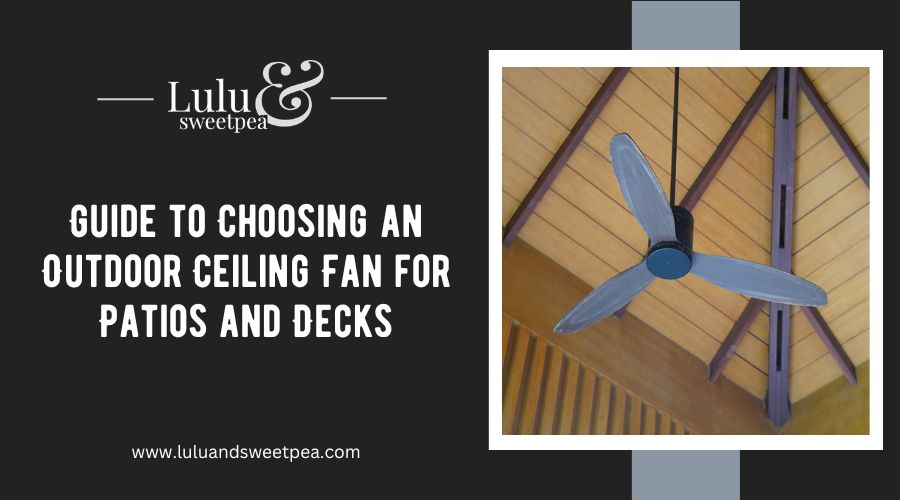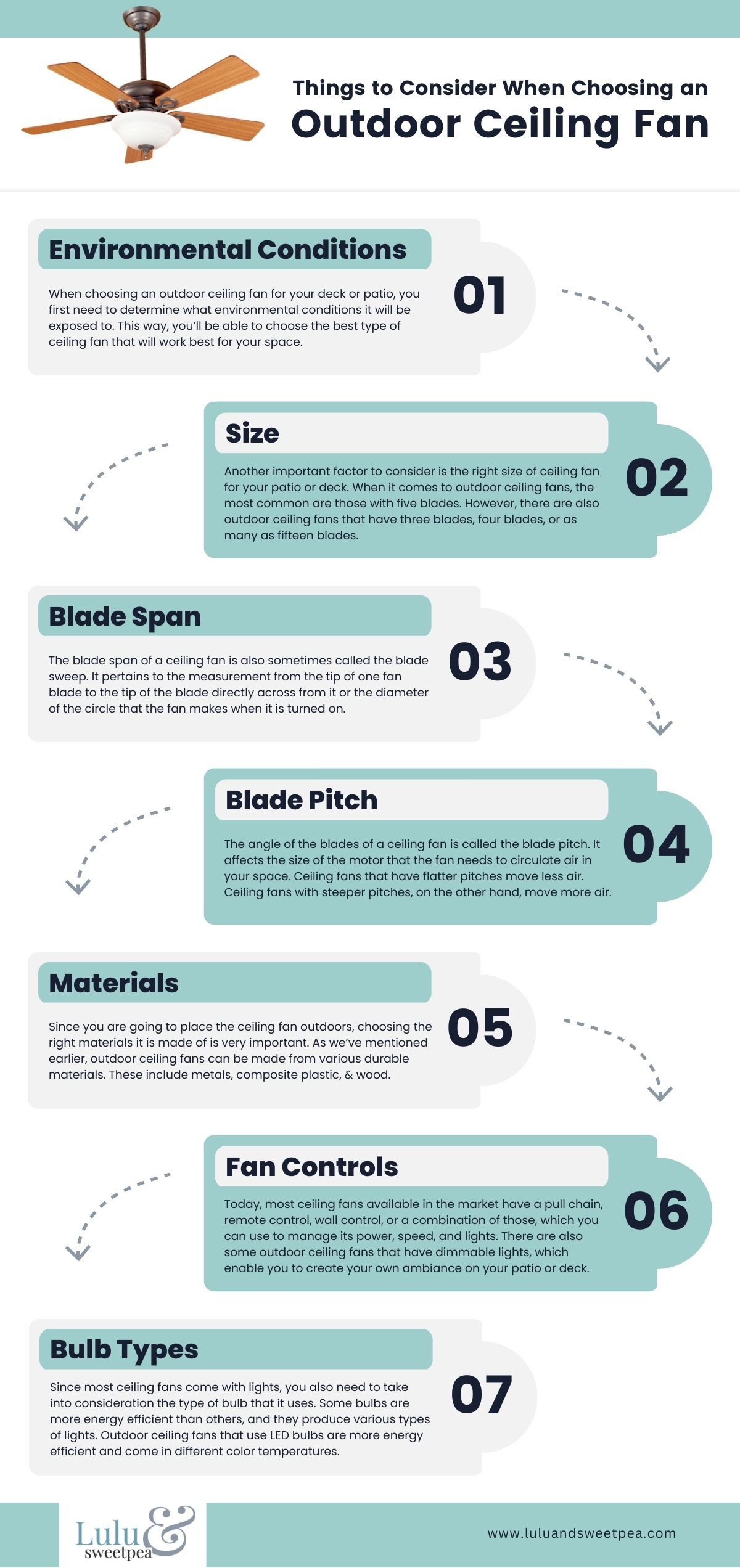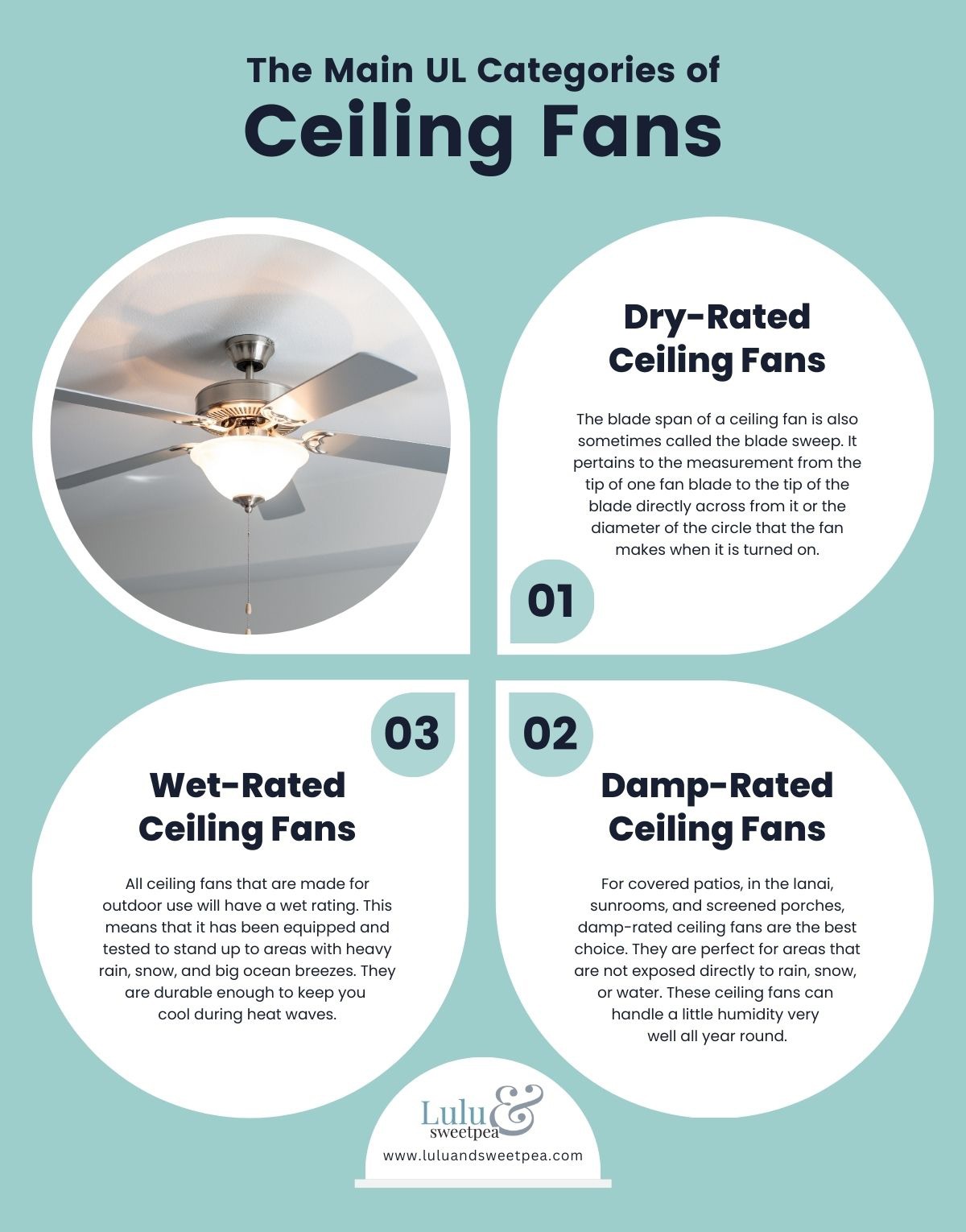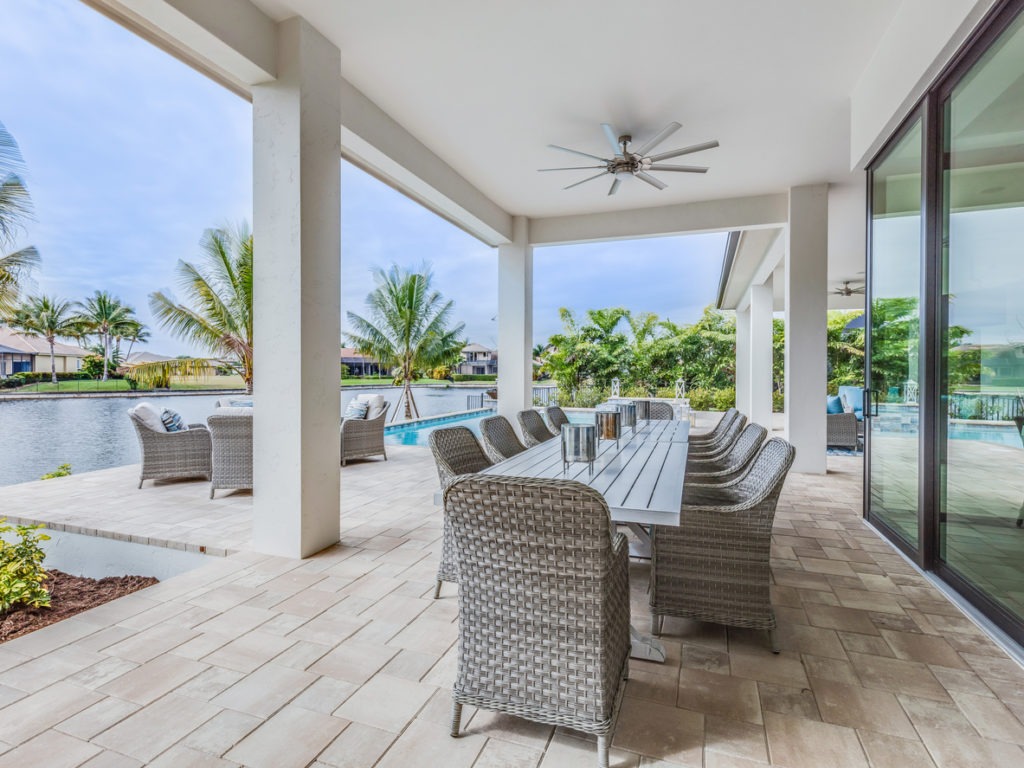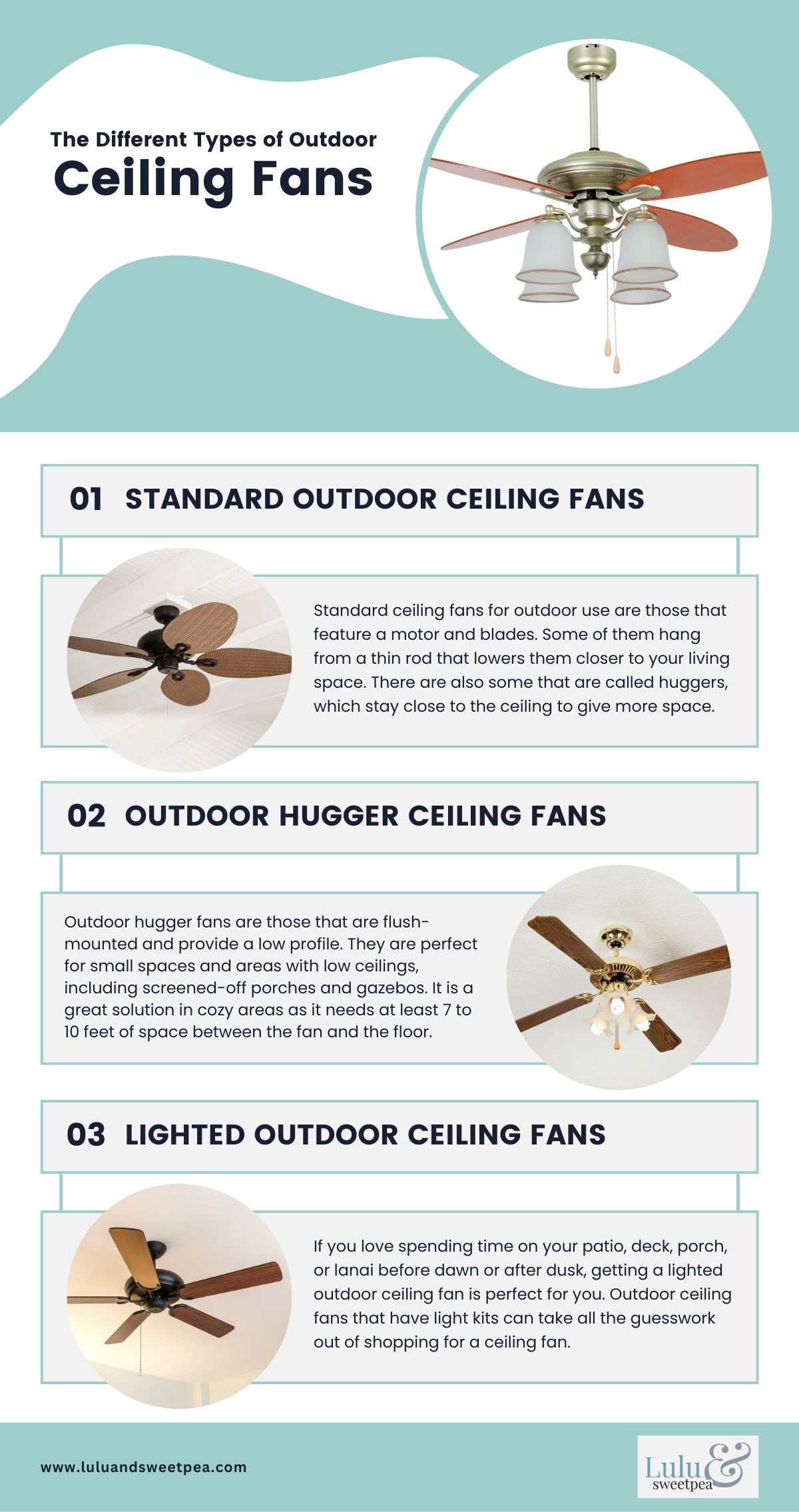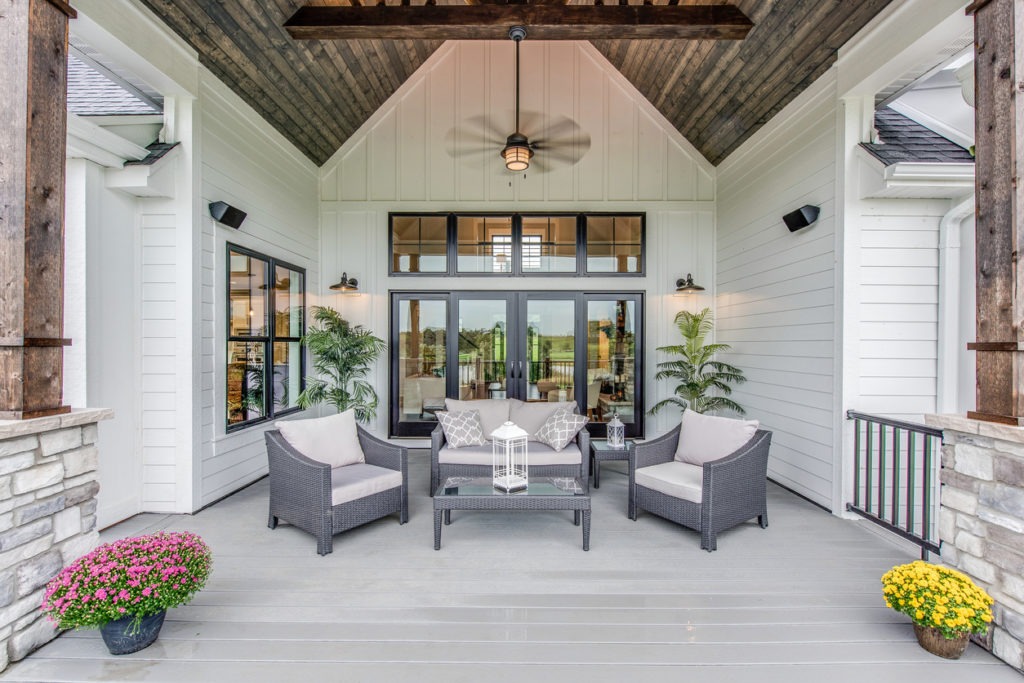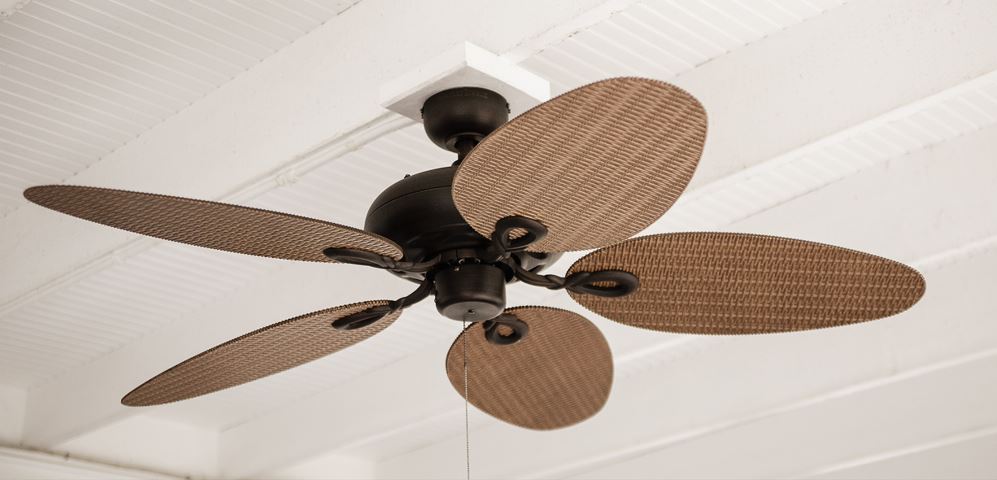The main purpose of ceiling fans is to keep us cool. While it doesn’t cool the air temperature, it makes us feel cooler as it moves the air around us, which is referred to as evaporative cooling. In addition to cooling down hot afternoons, ceiling fans also add a nice touch to any room. They are a combination of efficiency and aesthetics. There are various kinds of ceiling fans, and one of those is outdoor ceiling fans.
Outdoor ceiling fans still look similar to the ones that you can see indoors, but they are designed specifically to withstand the different environments of a patio or deck. They have features like all-weather fan blades made of durable materials like plastic and waterproof sealed motor casing. A lot of them are also made of steel and specialized paint and metal finishes that can protect the fan parts and ensure cleaner operation. [1]
For cooling down outdoor areas like patios, decks, and porches, an outdoor ceiling fan is a fantastic option. It’s a great way to stay refreshed, especially on warm summer days. Even your outdoor space’s style is accentuated by it. If you are thinking of buying an outdoor ceiling fan but can’t decide what to get, we are here to help you. In this post, we are giving you a guide to choosing an outdoor ceiling fan for patios and decks.
Things to Consider When Choosing an Outdoor Ceiling Fan
Choosing an outdoor ceiling fan can be a little overwhelming at first. But to make it a bit simpler, we have compiled the important things that you need to consider in order to find an outdoor ceiling fan for your deck or patio that can provide you with cooler air and great aesthetics.
Environmental Conditions
When choosing an outdoor ceiling fan for your deck or patio, you first need to determine what environmental conditions it will be exposed to. This way, you’ll be able to choose the best type of ceiling fan that will work best for your space. For example, if you plan to install it undercover or enclosed on more than one side, then a damp-rated fan is what you need, which we will discuss later.
Depending on the environmental conditions in your area, there are a few materials to look for which are more rust-resistant. Some of these include fans that have marine-grade stainless steel bodies and blades and those that have plastic motor housing and blades. They are less susceptible to the elements, ensuring longevity for as long as possible. [2]
Size
Another important factor to consider is the right size of ceiling fan for your patio or deck. When it comes to outdoor ceiling fans, the most common are those with five blades. However, there are also outdoor ceiling fans that have three blades, four blades, or as many as fifteen blades. You need to remember that the maximum size of the fan does not necessarily mean maximum airflow. Factors like speed, pitch, span, and distance from the floor can determine how much airflow the fan will provide. [1]
If you have a small space, choosing a small ceiling fan is recommended. It’s because if you opt for a large ceiling fan, you will likely have too much wind, which is uncomfortable. For bigger spaces, you might need to choose bigger ceiling fans or install two or more fans to circulate air well. It is also great if you can find fans that have shaped blades and very little overlap, as the space between blades helps in creating air movement.
When it comes to the number of blades, the more blades there is, the better airflow. However, adding blades will also add to the noise as the air moves, and the fan motor works harder, which can be distracting in social spaces like decks and patios. [1] Here’s to help you choose what diameter of the ceiling fan to consider:
- For spaces up to 75 square feet = 29-36 inches
- For spaces up to 76-144 square feet = 36-42 inches
- For spaces up to 144-225 square feet = 44 inches
- For spaces up to 225-400 square feet = 50-54 inches
Blade Span
The blade span of a ceiling fan is also sometimes called the blade sweep. It pertains to the measurement from the tip of one fan blade to the tip of the blade directly across from it or the diameter of the circle that the fan makes when it is turned on. Compared to short blades, longer blades move more air. Also, multiple well-placed smaller ceiling fans are better at providing effective airflow in a large space compared to a single large ceiling fan. [1]
Blade Pitch
The angle of the blades of a ceiling fan is called the blade pitch. It affects the size of the motor that the fan needs to circulate air in your space. Ceiling fans that have flatter pitches move less air. Ceiling fans with steeper pitches, on the other hand, move more air. Also, even though fans with flatter pitches can spin fast with a smaller motor, they still move less air. [1]
Materials
Since you are going to place the ceiling fan outdoors, choosing the right materials it is made of is very important. As we’ve mentioned earlier, outdoor ceiling fans can be made from various durable materials. These include metals, composite plastic, and wood. The housing of the motor can also match the color of the blade, or you can also opt for finishes that complement each other. The most popular motor housing and blade finishes include silver, bronze, white, and nickel. They can also come in different colors, such as black, white, dark wood, light wood, and more. [1]
Fan Controls
Today, most ceiling fans available in the market have a pull chain, remote control, wall control, or a combination of those, which you can use to manage its power, speed, and lights. There are also some outdoor ceiling fans that have dimmable lights, which enable you to create your own ambiance on your patio or deck. [1]
Bulb Types
Since most ceiling fans come with lights, you also need to take into consideration the type of bulb that it uses. Some bulbs are more energy efficient than others, and they produce various types of lights. Outdoor ceiling fans that use LED bulbs are more energy efficient and come in different color temperatures. Fluorescent bulbs, on the other hand, are inexpensive and can provide bright illumination. You can also opt for ceiling fans that use xenon or krypton bulbs that can provide clear, white light with a high-lumen output while consuming fewer watts of power. [1]
The Main UL Categories of Ceiling Fans
Underwriters Laboratories (UL) are popular when it comes to standards in electrical products. Some ceiling fans are specifically made to meet the UL ratings for outdoor use. This means that they are tested to stand up to rain, humidity, and salty sea breezes. Below are the three main UL categories of ceiling fans:
Dry-Rated Ceiling Fans
Ceiling fans that are dry-rated are only used indoors and should never be installed outdoors. They are not equipped to withstand moisture or changes in temperature. This means that when they are exposed to the elements outdoors, they are subject to different mechanical problems, which can be dangerous, too. [1]
Damp-Rated Ceiling Fans
For covered patios, in the lanai, sunrooms, and screened porches, damp-rated ceiling fans are the best choice. They are perfect for areas that are not exposed directly to rain, snow, or water. These ceiling fans can handle a little humidity very well all year round. [1]
Wet-Rated Ceiling Fans
All ceiling fans that are made for outdoor use will have a wet rating. This means that it has been equipped and tested to stand up to areas with heavy rain, snow, and big ocean breezes. They are durable enough to keep you cool during heat waves. Therefore, you can install wet-rated ceiling fans on sun-exposed decks, pergolas, verandas, and gazebos. [1]
The Different Types of Outdoor Ceiling Fans
While the main purpose of an outdoor ceiling fan is to circulate air and create a refreshing breeze while you are hanging out outdoors, it is also great if you can find one that has the perfect design that will make your patio or deck look more pleasing. To help you choose the best one, below are the different types of outdoor ceiling fans that you can choose from.
Standard Outdoor Ceiling Fans
Standard ceiling fans for outdoor use are those that feature a motor and blades. Some of them hang from a thin rod that lowers them closer to your living space. There are also some that are called huggers, which stay close to the ceiling to give more space. [1] Below are some examples of standard outdoor ceiling fans to help you choose:
- Hunter Cassius Outdoor Ceiling Fan: This outdoor ceiling fan has a modern design. It comes with matte black reversible blades. It has a quiet motor that can deliver ultra-powerful airflow. The speed of this ceiling fan can be quickly adjusted through the use of pull chains. The height of the fan is also adjustable for a more optimized air movement. It is a damp-rated outdoor ceiling fan, which is best for patios, porches, and sunrooms.
- Obabala Outdoor Ceiling Fan: This is a smart wooden ceiling fan that features a reversible motor that works quietly. It has two airflow modes, which can keep you cool in the summer and warm in the winter. It comes with a handheld remote control where you can adjust the fan at six speeds and three-level timing. It is also damp-rated, making it great for covered patios and other sheltered outdoor environments.
- Honeywell Palm Island Tropical Outdoor Ceiling Fan: This outdoor ceiling fan is perfect for medium-sized areas of up to 400 square feet. It is a 5-blade fan that gives ultimate airflow. It has three hanging options to suit different spaces. It is made of high-quality materials. It can be used in winter and summer seasons with its reversible fan. It is damp-rated, making it suitable for areas where moisture levels are high but are still protected from direct rain.
Outdoor Hugger Ceiling Fans
Outdoor hugger fans are those that are flush-mounted and provide a low profile. They are perfect for small spaces and areas with low ceilings, including screened-off porches and gazebos. It is a great solution in cozy areas as it needs at least 7 to 10 feet of space between the fan and the floor. [1] Below are some examples of outdoor hugger fans to help you pick:
- Matthews Outdoor Hugger Ceiling Fan: This outdoor ceiling fan includes a handheld, wall-mountable, 6-speed remote control with reverse function. It is suitable for ceiling heights 7’10” or greater. However, it is not recommended for vaulted ceiling mounts. It is damp-rated, making it great for covered patios and decks.
- Westinghouse Contempra Outdoor Ceiling Fan: This is a traditional outdoor ceiling fan that features 5 blades. It is ideal for large rooms of up to 225 square feet. It is weather-proof and can deliver powerful air movement and quiet performance.
- Casa Vieja Salerno Modern Industrial Hugger Outdoor Ceiling Fan: This is a 54-inch ceiling fan with an imperial bronze finish motor. It is a hugger fan that is only 8.5 inches from the ceiling to the blades and around 10 inches from the ceiling to the bottom of the light. The blades have a three-seasoned wood finish. It also has a dimmable LED light with a 3000K color temperature. It comes with a handheld remote control. It is UL listed for damp locations, making it great for covered decks and patios.
Lighted Outdoor Ceiling Fans
If you love spending time on your patio, deck, porch, or lanai before dawn or after dusk, getting a lighted outdoor ceiling fan is perfect for you. Outdoor ceiling fans that have light kits can take all the guesswork out of shopping for a ceiling fan. There are a lot of outdoor ceiling fans available, which are already assembled, featuring the light mount, fan controls, blades, a variable speed motor, and the hardware needed to put them together. A lot of them also include controllers for both the fan and the lights. [1] Below are the different examples of lighted outdoor ceiling fans to help you choose:
- Sofucor Outdoor Ceiling Fan with LED Light: This outdoor ceiling fan comes with a dimmable LED light that can illuminate your living space. The light features 3000K lumen that is warm white. It also features 1500 lumen with 15 watts of power. The fan also allows you to switch the direction of the fan from downward airflow in summer to upward airflow in winter. The fan and the light can be turned on and off separately.
- SMAAIR Smart LED Outdoor Ceiling Fan: This is an outdoor ceiling fan that uses a DC24v motor that is energy-efficient. It has multiple speeds that can bring a great amount of airflow. It has downdraft and updraft modes, making it great for all seasons. It comes with a dimmable LED light with 3-color temperatures, which are warm, natural, and daylight. It can be grouped with other smart devices to use voice commands. It is perfect to be used in damp locations, such as in patios, decks, and gazebos.
- Harbor Breeze Twin Breeze Outdoor Ceiling Fan: This is an award-winning double fan ceiling fan that can add aesthetic to your space. It features six brown wicker blades that make it easy to change styles without buying new blades. It also comes with a light kit with frosted glass shades that creates a bright flow. It is a 74-inch ceiling fan that is best for extra-large rooms.
Conclusion
It is indeed a great idea to install an outdoor ceiling fan on your deck or patio. This way, air will be regulated well to keep you cool during hot seasons and warm during cold seasons. In addition to that, outdoor ceiling fans can add beauty and style to your outdoor living spaces, making them look cozier and more aesthetic. There are lots of options when it comes to outdoor ceiling fans when you visit stores or browse online. This means that you can surely find one that will best fit your outdoor living spaces. We hope this post helped you learn more about choosing an outdoor ceiling fan for patios and decks.
